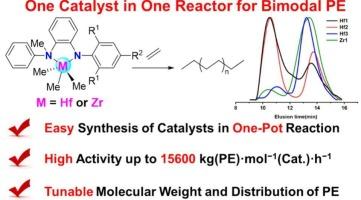Synthesis of bimodal polyethylene by unsymmetric hafnium and zirconium complexes bearing NN-Bidentate amino ligands
IF 6.3
2区 化学
Q1 POLYMER SCIENCE
引用次数: 0
Abstract
Bimodal polyethylene is a class of high-performance polyolefin with excellent mechanical property and good processability. However, their synthesis usually requires two distinctive catalysts or two sequential processes that make it being a continuing challenge. In this contribution, a series of hafnium (Hf1–Hf3) and zirconium (Zr1) complexes bearing NN-bidentate amino ligands were developed to synthesize bimodal polyethylene using one catalyst in one reactor, owing to their unique unsymmetric structures. These Hf and Zr complexes were easily synthesized by one-pot reactions of amino ligands with in situ formed MMe4 (M = Hf or Zr). All metal complexes were characterized by 1H and 13C NMR spectroscopy, and the molecular structure of Hf1 was determined by single-crystal X-ray diffraction. These Hf and Zr complexes exhibited high activity toward ethylene homopolymerization (up to 15600 kg(polymer)·mol−1(M)·h−1) and ethylene/1-octene copolymerization (up to 4320 kg(polymer)·mol−1(M)·h−1). The resulting polymers showed tunable molecular weights with bimodal distributions for most cases. The polymerization results revealed the nature of the ligand strongly influenced the catalytic performance, and those with electron-donating substituents promoted polymerization. Furthermore, the activity of Hf1 was higher than that of Zr1 analogue with the same ligand, underscoring the metal center played a critical role in catalytic properties.

含n -双齿氨基配体的不对称铪锆配合物合成双峰聚乙烯
双峰聚乙烯是一类具有优异力学性能和良好加工性能的高性能聚烯烃。然而,它们的合成通常需要两种不同的催化剂或两个连续的过程,这使得它成为一个持续的挑战。在这篇贡献中,由于其独特的不对称结构,开发了一系列含有nn -双齿氨基配体的铪(Hf1-Hf3)和锆(Zr1)配合物,用于在一个反应器中使用一种催化剂合成双峰聚乙烯。这些Hf和Zr配合物很容易通过氨基配体与原位形成的MMe4 (M = Hf或Zr)一锅反应合成。所有金属配合物均通过1H和13C NMR进行了表征,Hf1的分子结构通过单晶x射线衍射进行了测定。这些Hf和Zr配合物具有较高的乙烯均聚合活性(可达15600 kg(聚合物)·mol−1(M)·h−1)和乙烯/1-辛烯共聚活性(可达4320 kg(聚合物)·mol−1(M)·h−1)。所得聚合物在大多数情况下具有双峰分布,分子量可调。聚合结果表明配体的性质对催化性能有较大影响,配体上有供电子取代基的配体对聚合有促进作用。此外,Hf1的活性高于相同配体的Zr1类似物,说明金属中心在催化性能中起着关键作用。
本文章由计算机程序翻译,如有差异,请以英文原文为准。
求助全文
约1分钟内获得全文
求助全文
来源期刊

European Polymer Journal
化学-高分子科学
CiteScore
9.90
自引率
10.00%
发文量
691
审稿时长
23 days
期刊介绍:
European Polymer Journal is dedicated to publishing work on fundamental and applied polymer chemistry and macromolecular materials. The journal covers all aspects of polymer synthesis, including polymerization mechanisms and chemical functional transformations, with a focus on novel polymers and the relationships between molecular structure and polymer properties. In addition, we welcome submissions on bio-based or renewable polymers, stimuli-responsive systems and polymer bio-hybrids. European Polymer Journal also publishes research on the biomedical application of polymers, including drug delivery and regenerative medicine. The main scope is covered but not limited to the following core research areas:
Polymer synthesis and functionalization
• Novel synthetic routes for polymerization, functional modification, controlled/living polymerization and precision polymers.
Stimuli-responsive polymers
• Including shape memory and self-healing polymers.
Supramolecular polymers and self-assembly
• Molecular recognition and higher order polymer structures.
Renewable and sustainable polymers
• Bio-based, biodegradable and anti-microbial polymers and polymeric bio-nanocomposites.
Polymers at interfaces and surfaces
• Chemistry and engineering of surfaces with biological relevance, including patterning, antifouling polymers and polymers for membrane applications.
Biomedical applications and nanomedicine
• Polymers for regenerative medicine, drug delivery molecular release and gene therapy
The scope of European Polymer Journal no longer includes Polymer Physics.
 求助内容:
求助内容: 应助结果提醒方式:
应助结果提醒方式:


